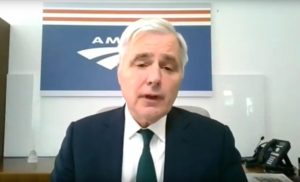
WASHINGTON — Amtrak President William Flynn has told members of Congress that the company needs a $4.9 billion appropriation for fiscal 2021 to avoid employee furloughs and reduced long-distance train frequencies planned for October.
Flynn, Rail Passengers Association President and CEO Jim Mathews, and labor officials representing the Transport Workers Union and Transportation Communications Union testified Tuesday at the U.S. House Transportation and Infrastructure Committee’s Rail Subcommittee hearing titled, “Amtrak’s response to COVID-19.”
Amtrak declined to provide the figure needed to avoid the job and service cuts to Capitol Hill staffers until late last week, despite requests from elected officials in June [see “Senators seek more details on Amtrak service, job cuts,” Trains News Wire June 29, 2020.
That drew sharp criticism in the opening statement from subcommittee chairman Dan Lipinski (D-Ill.) for “just now submitting their amended FY21 supplemental request to Congress less than one month before the current fiscal year expires and Amtrak plans to implement these furloughs.”
If Senate and House conferees don’t come up with the $4.9 billion (which includes the $2 billion Amtrak originally asked for in its annual Grant and Legislative Request in February), Flynn told Lipinski that with a “cash burn at nearly $250 million a month right now, we would have to make very dramatic reductions across the company to stave off bankruptcy.” He added that this would include “substantial reduction in all services and perhaps some elimination of some long-distance services if that’s the cash burn we’re having with no supplemental funding.”
In questioning from U.S. Rep. Brian Babin (R-Texas), Flynn repeated management’s previous assertions that in fiscal 2019, “we were generating a surplus on our Northeast Corridor — essentially a break-even level of operation in our state-supported network, but the operational subsidy fundamentally underpins the long-distance services. So the vast majority, if not all, of that subsidy, if we were to do it on a service line basis, would be on the long-distance service.”
Rail Passengers Association President and CEO Jim Mathews pushed back against Flynn and the assertion by Babin and four other GOP lawmakers that Amtrak is required to make a profit.
“It is not — it is only required to minimize subsidies,” Mathews said. “A conversation about (Amtrak) profit ignores the benefit that communities receive.” In his opening statement, he unveiled research that quantifies by long-distance route exactly what those benefits are.
The document lists the direct and indirect economic impact of daily service, and the negative effects when four of seven weekly departures are eliminated.
The model, developed by the Rail Passengers Association with the help of Transportation 4 America, contends that the cuts will result in a “$2 billion bomb on ‘Flyover Country.’” It is available here.

Other revealing exchanges during the session:
— Rep. Scott Perry (R-Pa.) raised concerns about aspects of Amtrak’s accounting methodology, such as considering taxpayer-funded state payments as revenue and not including depreciation in operating results.
— Flynn said that there were no plans to furlough any employees at the Beech Grove Heavy Maintenance Facility, and in fact Amtrak had to hire essential workers after some employees decided to take the company-wide buyout offer.
— Acela lead service attendant Amy Griffin, who testified as Local 1460 president of the Transport Workers Union of America, recounted a July incident in which she had been ordered to continue working after a co-worker tested positive for COVID-19. She eventually was told to quarantine, but then was ordered back to work after 10 instead of 14 days by Amtrak’s medical staff because she showed no symptoms
— Flynn was criticized by several lawmakers for reinstating a 401K retirement plan company match for management beginning Oct. 1 at the same time it counted on receiving bailout money and was laying off 2,000 employees. He defended the decision because it helped the company retain personnel and would not agree to reverse it, but did say Amtrak would withdraw a communications Request For Proposal that allowed outsourced bidders to shift jobs offshore.
–Near the end of session, Rep. Stephen Lynch (D-Mass.) told Flynn, “I fully support using money you make on the north end of the Northeast Corridor to provide service to some of those rural areas — the ‘red’ states. Those lines don’t necessarily benefit my district but they benefit the country. … I hope you take very seriously the credibility that you will lose by engaging in these furloughs, and the representational damage that comes to Amtrak management. I’m asking you to reconsider that [because] it is not going to save the day.” Cutting 2000 employees, Lynch said, “is going to reduce service and spiral that bottom-line deficit. You’re going to lose the faith of members of Congress like me, who are behind you, because of this decision.”
Video of the entire 2 1/2 -hour hearing and links to the witnesses’ prepared testimony is available here.













